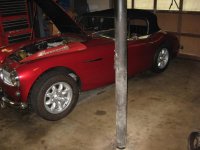maxwedge5281
Jedi Warrior
Offline
i recently changed my wheels from minilite look spline drive to real minilite bolt ons on my v8 powered bj7. i have changed over to the longest arp 7/16 by 20 thread wheel studs. these are approximately 2 7/8 inches long below the head of the stud. with the standard minilite offset on 6 by 15 wheels i had to reduce my rear tire size from a 225/60/15 to a 195/60/15. if i could use a wheel stud one half inch longer i could put in a quarter inch spacer and add a couple of tire sizes on the rear. have any of you racers upgraded to 1/2 inch wheel studs? thanks for any help or advice.
 .
.
 .
.
 Hi Guest!
Hi Guest!

 smilie in place of the real @
smilie in place of the real @
 Pretty Please - add it to our Events forum(s) and add to the calendar! >>
Pretty Please - add it to our Events forum(s) and add to the calendar! >> 



